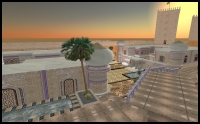By Kara Andrade, August 2, 2007
The final event of the Faces of Faith in Second Life Showcase and Conversation was a panel discussion held on Sunday, July 29 from 12-1:30 PM PST held in-world and broadcast live through SLCN, the Second Life Cable Network, http://slcn.tv. Religion writer and News21 Senior Editor Don Lattin moderated. Panelists included Second Life worshipers, spiritual leaders, anthropologists and theologians.
Event Transcript
Don Lattin's Opening Remarks
Hello, and welcome to our little experiment here in Second Life. In Real Life, my name is Don Lattin, and I am a writer. Unlike most people in Second Life. I have the same name and same job in the Real World and in Second Life - DonLattin Writer. Maybe I suffer from a virtual lack of imagination. I do have fantasies, but I don't care to share them with you all at the moment. Before we get rolling, let me apologize in advance for any Second Life faux-pas I make during my presentation. I'm a stranger in this strange land, having only heard about the place a couple months ago, and having only logged in a a few hours of flying time so far.
We've been hanging out on the island for nearly a week now showcasing the work of a team of journalists from the Graduate School of Journalism at the University of California, Berkeley exploring "God, Sex and Family." We chose that title for two reasons. We wanted to get your attention, and we think that's where choices about marriage, dating, the building of community, family and faith play out in private life. To see our work as it unfolds over the next few weeks, go to www.newsinitiative.org/ucb .
"God, Sex, Family" projects are being streamed (video, audio, content) into different tents created to look and feel like a church revival. The tents, such as "My Brother, The Christian," the "Moral Compass" and our "Data Road Trip" will highlight stories and interactive info-graphics reported on and created by the fellows in our News21 project.
News 21 is a national initiative led by five leading universities (UC Berkeley, USC, Columbia, Northwestern and Harvard) and funded by the Carnegie-Knight Initiative on the Future of Journalism Education. My colleague at the Berkeley School of Journalism, Bob Calo, and myself have been leading the Berkeley effort. "Leading" may not be the right word. Bob and I have been hanging out of a group of 12 (tk) recent graduates - all of them very smart and tech-savvy -- learning how to operate in this strange new world of viritual journalism.
We're gathered here on Nowhere Island for a panel discussion on religion on the Internet, and more specifically, religion in Second Life. We'll be looking at how people experience spirituality in Second Life - things like prayer, evangelism/proselytizing and congregational life is different in Second Life and Real Life. Or is it? Does the anonymity of Second Life foster or impede the spiritual connection between people of faith and between people and God? Do some religions work better than others in Second Life and the Internet? Does the "anything goes" philosophy of Second Life get in the way of authoritative religious teachings? Can groups with a history on animosity - like Muslims and Jews - find common ground in Second Life?
Our plan today is to give each of them two-three minutes to talk about their ministries (different word?) here in Second Life, then I'll ask some questions to get the discussion going. There will be a question and answer period at the end of the event. Please make sure to hold your questions until then and please send those questions to KaraAndrade Writer, the UC Berkeley fellow who's masterminded this whole thing.
And then it's party time -- which may be the real religion of Second Life.
If everything is working right today, and don't blame me if it isn't, this event is being broadcast live from SL (Second Life) to RL (Real Life) via the Second Life Cable Network http://slcn.tv/ so people don't have to login to Second Life to listen in and participate.
We have a distinguished panel of speakers with us here today.
Muhammedyussif Wikinger
Lives in Sweden, 63 years old, embraced Islam 20 years ago and is now board member of the Chebi mosque support group in SL. He works as psychiatrist in real life.
Franko Corleone/Frank Scott
Frank, 48, is a respected technology futurist in Australia. He has been a Hare Krishna devotee for many years and follows Bhaktivedanta Narayana Maharaja as his spiritual master. In January 2007 he created a virtual temple, now the "Hare Krishna community welcome area".
Otenth Paderborn/ Kenneth Sutton
Managing editor of UU World and uuworld.org. Also founded the Religious Society of Friends (Quakers) group in SL in January 2007, and the resulting First Friends Church of
Second Life, which has been meeting weekly for worship since February.
Beth Odets/Beth Brown
Founded the Second Life Synagogue (SLS) or the Temple Beth Israel in September 2006.
She is part of the Live Music scene in SL, and tends to spontaneously have live Violin shows, mixing requests with traditional Jewish folk music, a little classical here and there, and tons of Broadway show tunes.
Tom Bukowski / Tom Boellstorff.
Tom Boellstorff is Associate Professor in the Department of Anthropology at the University of California, Irvine. He is also currently Editor-in-Chief of American Anthropologist, the flagship journal of the American Anthropological Association.
